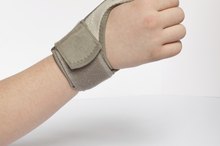The Duration of a Broken Finger
A broken, or fractured, finger may not seem as serious as a break in one of your bigger bones, but it is essential that you treat the injury properly to prevent range of motion issues in the future. You will probably have to wear a splint or cast to immobilize the finger while it heals and, depending on the severity of the break, this can take three to six weeks.
Symptoms
According to the American Academy of Orthopaedic Surgeons, a broken finger often occurs due to a forceful impact to your hand, such as slamming your fingers in a door, putting your hands out to break your fall or catching a ball the wrong way 2. The main signs of a broken finger are swelling and/or bruising around the injury and pain when moving the affected finger or the entire hand. If you think you may have sustained a break, see your doctor so the injury can be treated properly to ensure full recovery.
- According to the American Academy of Orthopaedic Surgeons, a broken finger often occurs due to a forceful impact to your hand, such as slamming your fingers in a door, putting your hands out to break your fall or catching a ball the wrong way 2.
- The main signs of a broken finger are swelling and/or bruising around the injury and pain when moving the affected finger or the entire hand.
Initial Treatment
When Can You Go Back to Normal Activities After a Broken Finger?
Learn More
In most cases, when the break is simple, your doctor will realign the broken bone and immobilize your finger with a cast or splint to ensure the bones don’t move out of alignment during the healing process. If your finger bones heal in the wrong position, you may experience pain and stiffness in the affected joints and your hand function may be reduced. For more serious breaks that involve more than one bone and/or a crushing of the bones, surgery may be required to pin or wire the bones back together.
- In most cases, when the break is simple, your doctor will realign the broken bone and immobilize your finger with a cast or splint to ensure the bones don’t move out of alignment during the healing process.
- For more serious breaks that involve more than one bone and/or a crushing of the bones, surgery may be required to pin or wire the bones back together.
Healing Time Frame
Finger fractures are typically immobilized in a splint for three to four weeks until your finger is no longer sensitive to impact. Once the splint is removed, the finger may be wrapped to the adjacent finger for protection for an additional week or two until the bone is fully healed.
Severe finger fractures may require surgical placement of plates, screws or pins to hold the bones in proper position. After surgery, a cast is typically worn for two weeks, then you may be transitioned into a removable splint for an additional four weeks or longer, depending on the severity of your injury. Your doctor will take x-rays to determine when your finger is fully healed.
- Finger fractures are typically immobilized in a splint for three to four weeks until your finger is no longer sensitive to impact.
- Once the splint is removed, the finger may be wrapped to the adjacent finger for protection for an additional week or two until the bone is fully healed.
Precautions and Prevention
What Causes Finger Joint Pain?
Learn More
Most finger breaks heal completely with no long-term side effects. However, beginning rehabilitation too soon can make your injury worse and delay recovery. Start with gentle exercises and gradually increase the intensity and number of repetitions as you see your strength and mobility improving. Once you return to normal activity, taping the injured finger can help protect it from similar injuries in the future – particularly if you play contact sports.
- Most finger breaks heal completely with no long-term side effects.
- Once you return to normal activity, taping the injured finger can help protect it from similar injuries in the future – particularly if you play contact sports.
Related Articles
References
- American Academy of Orthopaedic Surgeons: Fracture of The Finger
- Practical Plastic Surgery for Nonsurgeons: Finger Fractures and Dislocations
- Beth Israel Deaconess Medical Center: ORIF (Open Reduction Internal Fixation) of a Fracture
- American Academy of Orthopaedic Surgeons, OrthoInfo. Mallet Finger (Baseball Finger). Updated March 2015.
- Bachoura A, Ferikes AJ, Lubahn JD. A review of mallet finger and jersey finger in the athlete. Curr Rev Musculoskelet Med. 2017;10(1):1-9. doi:10.1007/s12178-017-9395-6
- Cheung JP, Fung B, Ip WY. Review on mallet finger treatment. Hand Surg. 2012;17(3):439-47. doi:10.1142/S0218810412300033
- McKeon KE, Lee DH. Posttraumatic Boutonnière and Swan Neck Deformities. J Am Acad Orthop Surg. 2015 Oct;23(10):623-32. doi:10.5435/JAAOS-D-14-00272
Writer Bio
Jessica began her writing career in 1995 and is Senior Editor at a London communications agency, where she writes and edits corporate publications covering health, I.T., banking and finance. Jessica has also written for consumer magazines including "Cosmopolitan" and travel, home/lifestyle and bridal titles. Jessica holds a Bachelor of Arts in English literature and journalism from the University of Queensland.









